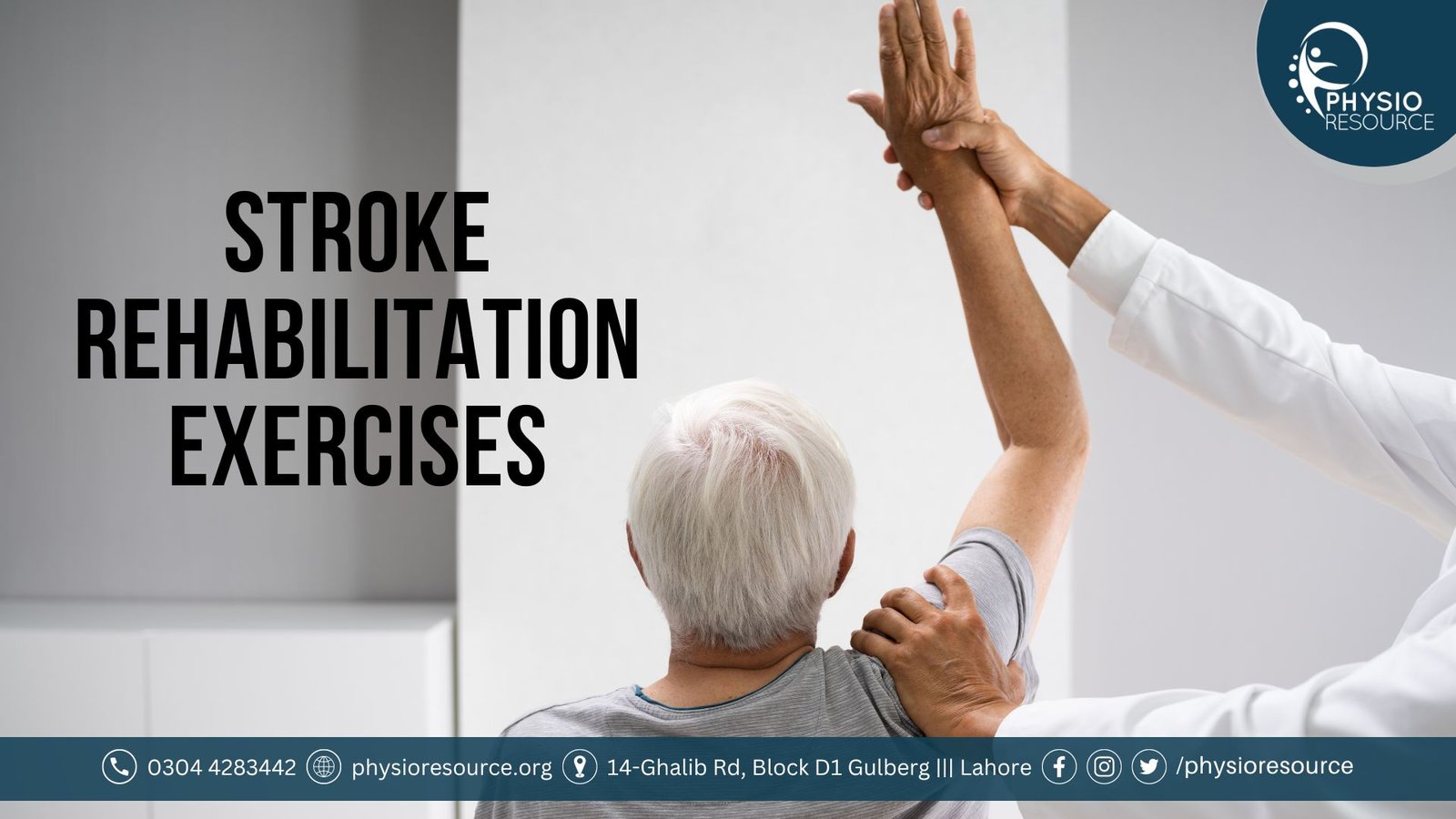Stroke Rehabilitation Exercises
Stroke Definition
A cerebrovascular accident (CVA), which is the medical term for a stroke, is an acute neurological event that is defined by an abrupt stoppage of blood supply to a particular area of the brain. It can be ischemic or hemorrhage stroke.
Introduction to Stroke Rehabilitation
A stroke can have a major effect on an individual’s capacity to move, coordinate, speak, think, and move. Rehabilitation after a stroke is important to help individuals in regaining their independence and enhancing their quality of life. Our best Physiotherapist in Lahore offers specialized stroke rehabilitation programs that use focused exercises to regain function, strength, and mobility at best Physiotherapy clinic in Lahore.
What are the Symptoms of Stroke?
- One side of the body experiencing paralysis or weakness; numbness or unusual sensations; issues with balance or coordination.
- Difficulty comprehending or producing speech, such as slurred speech or aphasia.
- Physical neglect—the patient ignores the side of their body that is impaired by the stroke; for instance, they might not eat on that side of the plate.
- Attention deficit/cognitive issues Difficulty swallowing
- Tiredness
- Issues with the bowel and bladder
- A shift in personality
- Depression
Also Read: Shoulder Strengthening Exercises at Home
Top Stroke Rehabilitation Exercises
The physiotherapy exercises for stroke patients are following:
Early post stroke exercises
Your chances of regaining lost talents and skills increase with the timing of your stroke therapy. While you’re still in the hospital, stroke rehabilitation often begins as soon as 24 to 48 hours following the stroke.
Three essential components made up the very early mobilization intervention were:
- Start as soon as possible after the stroke
- Concentrate on activities that require getting out of bed (such as sitting, standing, and walking,
- Produce three or more out-of-bed sessions every day in addition to standard treatment.
Type of physiotherapy exercises in stroke rehabilitation:
Following are the physiotherapy exercises for stroke in acute phase:
- Passive or active Range of Motion (ROM) Exercises
- Stretching exercises
- Functional Movement Exercises
- Fine motor skills training
- Strength training
- Coordination and balance exercises
- Breathing and Relaxation Exercises
- Mobility exercises
- Cardiovascular fitness exercises
Upper Limb Exercises:
Physiotherapy Exercises for upper limb in stroke rehabilitation are following
- Shoulder flexion
- Elbow extension
- Wrist stretches
- Passive Range of Motion (ROM)
- Active-Assisted ROM
- Strengthening: Simple resistance workouts, such as lifting tiny weights or squeezing a ball.
- Task-Specific Training: Practice repetitive actions such as grabbing, reaching, and picking up objects. Mirror therapy involves trying to move the afflicted arm while gazing at the unaffected arm in a mirror.
- Constraint-Induced Therapy (CIMT): Limiting the unaffected arm’s range of motion to promote the usage of the affected arm.
- Electrical Stimulation: This method involves stimulating muscles with low-level electrical impulses.
Lower Limb Exercises:
Physiotherapy Exercises for lower limb in stroke rehabilitation are following
- Passive ROM
- Active ROM
- sit to stand
- leg lift
- Heel slide
- weight shifts
- ankle pumps/ ankle dorsiflexion
- seated marches
- Assisted Walking: Use a walker or cane to practice walking
Core Strengthening:
- Bridging
- Seated Marching
- Pelvic tilts
- Superman posture
- Seated Trunk Twists Modified Planks
- Ball Squeeze between the knees
Functional and task specific training in stroke
- Sit to stand
- Walking Practice: focuses on balance and coordination and involves gait training with or without assistive technology.
Reaching and Grasping: Reaching for things, such as a cup, repeatedly helps to strengthen hand and arm coordination.
- Object Manipulation: Rebuilding fine motor skills involves picking up, holding, and arranging objects (such as cups or tiny items).
Dressing Practice: To relearn daily self-care skills, practice buttoning shirts, pulling up zippers, and putting on socks.
- Feeding Skills: Using cutlery to eat enhances strength and hand-eye coordination.
- Toileting and Hygiene: Learning how to do personal hygiene chores on your own, such as wiping and hand washing.
Balance exercises: To enhance postural control, try standing on one leg or adjusting your weight.
Stair Climbing: To regain your ability to climb stairs, practice step-ups.
Practice for Cognitive Tasks: playing games and puzzles.
- Occupational therapy in stroke rehabilitation
- Speech therapy in stroke rehabilitation
Stroke Treatment in Lahore
Physiotherapy after a stroke is important to help individuals in regaining their independence and enhancing their quality of life. Our physiotherapy clinic in Lahore, Physio Resource, give the best physiotherapy treatment after stroke in Lahore. Book your appointment now if you or your love on suffering from stroke.
Contact us
Phone No: 0304-4283442
Address: 14-Ghalib Rd, Block D1, Gullberg III, Lahore
















